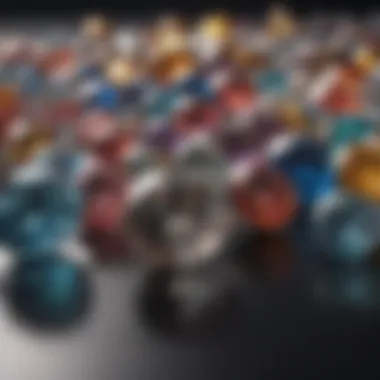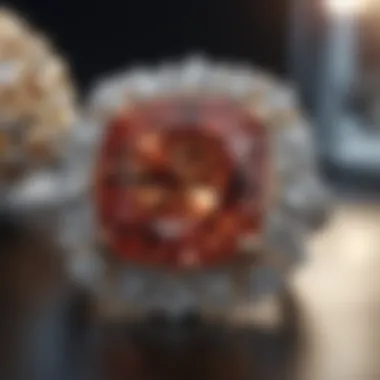Where to Buy Diamond Stones: Your Complete Guide


Intro
Understanding where to buy diamond stones is crucial for both novice and seasoned gemstone enthusiasts. Diamond stones represent not only a significant financial investment but also a deep connection to nature's artistry. Knowing the various options and strategies available for purchasing these valuable stones is essential. A comprehensive guide will help potential buyers navigate the complexities of the gemstone market and make informed decisions.
The diamond's allure comes from its remarkable hardness and refractive properties, but the purchasing process can be fraught with challenges. Knowledge of grading, types of retailers, and common pitfalls will empower buyers. Moreover, grasping the broader context of gemstones can enhance appreciation.
In this guide, we will explore several facets of diamond acquisition, enabling readers to approach their purchases with confidence.
Understanding Diamond Stones
Understanding diamonds is vital for anyone looking to buy them, as knowledge can empower the buyer. Diamond stones are not just mere gemstones; they carry a rich history and symbolize various significances such as love, commitment, and wealth. Without a solid grasp of what diamond stones are, buyers may find themselves overwhelmed by choices, unable to make informed decisions.
An in-depth understanding allows buyers to appreciate the intricate details and unique features that differentiate one diamond from another. This encompasses everything from the stone's natural attributes to how it is graded, which can ultimately influence its price and desirability. Additionally, being knowledgeable can protect one from common pitfalls, ensuring a satisfying purchase experience.
Nature of Diamond Stones
Diamonds are essentially formed deep within the Earth under high pressure and temperature. Most natural diamonds are billions of years old. Their unique formation process gives them distinct qualities that many people find appealing. Their brilliance and refractive quality are unmatched by other gemstones, adding to their allure.
Natural diamonds take millions of years to form, making each one unique based on its origin. Every diamond tells a story, not only through its cut and clarity but also through its geological background. The nature of diamond stones emphasizes their scarcity and desirability in the jewelry market.
Types of Diamond Stones
When considering a diamond purchase, it is essential to understand the various types available, as each offers something different based on individual preferences and requirements.
Natural Diamonds
Natural diamonds are mined directly from the earth. Their primary characteristic is their authenticity and uniqueness, as no two natural diamonds are identical. They are often considered traditional choices for engagement rings or special occasions.
Key Characteristics: Natural diamonds are revered for their enduring value and rarity. Their appeal lies in their natural formation process, which many consider an integral part of their beauty.
Advantages: They typically hold their value well in the long term. Their natural rarity often makes them a preferred choice for investors as well as collectors.
Disadvantages: Natural diamonds can be significantly more expensive than lab-created versions. Their extensive mining processes can also raise ethical questions regarding environmental impact and labor practices.
Lab-Created Diamonds
Lab-created diamonds are synthesized using technology that replicates the natural diamond-forming environment. They possess the same physical and chemical properties as natural diamonds.
Key Characteristics: The significant aspect of lab-created diamonds is their affordability. Because they can be produced in a controlled environment, they usually cost less than natural diamonds.
Advantages: They can be more affordable, offering excellent value for money. Additionally, consumers often find peace of mind knowing they are sourced responsibly with no environmental degradation.
Disadvantages: Some still view lab-created diamonds as less desirable than natural ones due to their synthetic origins. They may also not have the same long-term value retention as their natural counterparts.
Fancy Colored Diamonds
Fancy colored diamonds are a rare type and come in various colors, such as blue, pink, and yellow. Their color intensity can vary significantly, adding to their uniqueness.
Key Characteristics: The intriguing aspect of fancy colored diamonds is their vibrant colors. This uniqueness often makes them coveted in the luxury jewelry market.
Advantages: Their rarity means they can sometimes be more valuable than traditional colorless diamonds. They provide a distinctive choice for consumers looking for something unusual.
Disadvantages: The price can fluctuate widely based on color grade, size, and market demand. Interest in these stones may require more specialized knowledge for effective evaluation and purchase.
Understanding the different types of diamond stones can significantly influence your purchasing decision, tailoring your choice to your specific needs and desires.
Key Considerations Before Purchase
When it comes to acquiring a diamond stone, there are several key factors that one must keep in mind. These considerations play a vital role in ensuring that the purchase aligns with one's expectations and needs. Without these insights, individuals might find themselves overwhelmed by choices and potentially overpaying for an unsuitable product.


An awareness of these elements promotes better decision-making, ultimately leading to a satisfying experience. Key considerations include establishing a budget, understanding the grading of diamonds, and clarifying the purpose of the purchase. These conditions act as a framework for the buyer, allowing them to navigate through the options with confidence and clarity.
Setting a Budget
Setting a budget is an essential first step in the diamond buying process. Costs can range vastly depending on various factors like quality, size, and market demand. Establishing a clear monetary boundary helps in narrowing down options. Moreover, a budget prevents impulsive purchasing, which is common when faced with dazzling stones. It is wise to balance desires with financial capacity.
By defining a budget beforehand, buyers can focus on diamonds that meet their preference while staying within financial limits. This strategic approach can avoid future regrets and unexpected financial burden.
Understanding Diamond Grading
Grading plays a crucial role in determining the quality and value of a diamond. There are four primary criteria in the grading process, often referred to as the "Four Cs." This includes Cut, Color, Clarity, and Carat Weight.
Cut
The Cut of the diamond highly influences its appearance and brilliance. A well-cut diamond reflects light beautifully, enhancing its visual appeal. It is a critical factor that can elevate an average stone into something remarkable.
Key characteristic of a diamond's cut is that it directly impacts how it sparkles. A diamond with an excellent cut can appear more vibrant even when smaller in size. Buyers often prefer well-cut diamonds as they present the best visual qualities. However, a trade-off exists. Higher quality cuts generally mean higher prices.
Color
Color grading refers to the presence of color in a diamond, where the best diamonds are virtually colorless. The value decreases as colors become visible. Buyers typically look for D to F colored diamonds for engagement rings or fine jewelry because of their purity.
The unique feature about color in diamonds is that it is assessed on a scale. This allows for a standard measure which can guide buyer’s decisions. However, a colorless or near-colorless diamond can come at a premium price.
Clarity
Clarity assesses the presence of internal or external imperfections. The fewer imperfections, the higher the clarity grade. This grade contributes to the diamond's sparkle and overall value. Most buyers prefer diamonds that are SI1 or higher for jewelry, ensuring a clear, attractive stone.
Clarity's important aspect is that while high clarity increases value, it can also limit options. Lower clarity diamonds can offer unique beauty at an accessible price. Therefore, understanding clarity aids buyers in managing expectations versus budget.
Carat Weight
The Carat Weight indicates the size of the diamond. Larger diamonds generally cost more, but not all buyers prefer size over quality. They may prioritize cut, color, or clarity over carat weight for their ideal stone.
The unique feature of carat weight is its direct correlation to price. Every increment in carat can substantially raise costs. Therefore, balanced consideration of weight alongside grading is necessary when selecting a diamond.
Purpose of Purchase
Clarifying the purpose of the diamond purchase can influence choices significantly. Different occasions call for different considerations, All buyers must reflect on why they seek a diamond.
Engagement Jewelry
When selecting an engagement ring, emotional aspects often lead the decision. Engagement jewelry symbolizes commitment. Many buyers prioritize quality and aesthetics, focusing on cut and clarity to provide the best impression.
The unique feature of engagement rings is that they are personal. Buyers often choose diamonds that represent their unique relationship, making it important to find quality stones that reflect this significance.
Investment
Purchasing diamonds as an investment requires a different approach. Buyers should look for high-quality stones that retain value over time. Understanding market trends and resale aspects becomes crucial in making an informed purchase.
Investment-focused purchases often lead buyers to prioritize grading factors more heavily. Buying in this context requires mindfulness of market fluctuations and research into the right diamonds that will endure or even appreciate in value.
Collection
For collectors, the purpose often lies in acquiring unique or rare specimens. Each diamond may have a story, or come from a particular mine that draws interest. A collector should focus on distinctive qualities, which may include unusual colors or famous provenance.
The unique element of collecting differs from other purchases. A collector’s desire often ties less to market value and more to personal passion or historical interest for the stone. Thus, collectors must take time to study individual pieces to enrich their collections meaningfully.
Where to Buy Diamond Stones
Acquiring diamond stones requires careful consideration of where to buy. This guide helps navigate through different purchasing routes. Knowing the options available, their strengths, and weaknesses is crucial. Each avenue has specific advantages that can influence decision-making. For instance, buying online can offer convenience, while local stores allow for personal inspection of the diamonds. Thus, understanding these options can lead to more informed purchases.


Online Retailers
Reputable E-commerce Platforms
Reputable e-commerce platforms play a significant role in the world of diamond acquisition. Websites like Amazon, eBay, and other large online retailers provide extensive selections. A key characteristic of these platforms is their wide reach and variety. Buyers enjoy the convenience of browsing from home, which can make the search process more manageable.
These platforms often feature robust return policies, ensuring a layer of buyer protection. However, a disadvantage may include limited personal interaction with the product prior to acquisition. Online images might not always represent the true quality of the diamond, which can lead to unexpected disappointment on delivery.
Specialized Gemstone Websites
Specialized gemstone websites, such as James Allen and Blue Nile, focus entirely on jewelry and gemstones. This characteristic makes them a valuable resource when searching for diamonds. They often include detailed specifications about each diamond, such as grading reports, which aids consumers in making informed decisions.
These sites typically offer high-quality images and even 360-degree views of the diamonds. This feature allows customers to examine stones closely. However, prices on specialized websites may sometimes be higher, reflecting the focused niche and quality of services they provide in comparison with general e-commerce sites.
Brick-and-Mortar Stores
Jewelry Stores
Jewelry stores represent a more traditional option for purchasing diamond stones. Their primary advantage is the ability to physically view and inspect diamonds. This tactile experience can significantly affect buyer confidence. Customers can see the stone in various lighting conditions and assess its qualities directly, which is often reassuring.
A downside includes possibly higher prices compared to online retailers due to overhead costs. Additionally, the selection may be more limited than what can be found online, which might necessitate going from store to store.
Gem Shows
Gem shows are another interesting route for obtaining diamonds. These events bring together many dealers. The key characteristic of gem shows is the variety of stones available all in one location. It offers the chance to negotiate prices directly with sellers. Buyers can often find unique stones not available in traditional stores.
However, the ambiance of a large show can be overwhelming. Buyers may also need to dedicate a substantial amount of time to sift through many options to find the desired diamond.
Auctions and Estate Sales
Auctions and estate sales provide an alternative path to acquiring diamonds. These venues can yield unique finds that are irreplaceable. Buyers must research thoroughly before participating. Many items at these events come with various levels of documentation regarding authenticity and quality. Prices may vary widely, often presenting both opportunities and risks.
Private Dealers and Gem Exhibitors
Private dealers and gem exhibitors cater to those who prefer a more personalized buying experience. The unique feature of these suppliers is their ability to offer tailored advice and insights. Established relationships often enhance trust and security. However, potential pitfalls include the requirement for extensive personal knowledge about diamonds to avoid overpaying or acquiring inferior quality gems.
Evaluating Retailers
When purchasing diamond stones, one of the most critical steps is evaluating the retailers. This not only ensures that you are dealing with a legitimate seller but also impacts the overall satisfaction of your buying experience. Knowing how to assess the retailer effectively can save you from potential fraud and help you get the best value for your investment.
There are specific elements you should consider when evaluating diamond retailers. These include their credentials, return policies, and customer reviews. Each of these aspects plays a vital role in forming a complete picture of the retailer's reliability and credibility.
Additionally, understanding the benefits of a thorough evaluation process can lead to informed and confident purchasing decisions. In the world of diamonds, where the financial stakes are high and emotions can run deep, making informed choices becomes paramount.
Verifying Credentials
Verifying the credentials of a retailer is essential. It involves checking if the retailer is recognized by reputable organizations such as the Gemological Institute of America (GIA) or the International Gemological Institute (IGI). These certifications indicate that the retailer adheres to specific standards of quality and ethics in the gem trade.
You may also want to ensure that the retailer holds necessary licenses to operate in your region. This can often be confirmed through your local regulatory body. A retailer with solid credentials demonstrates a commitment to transparency, which can foster trust during your purchase.
Understanding Return Policies
A retailer’s return policy is another critical factor. A clear and fair return policy provides peace of mind in case the diamond does not meet your expectations. You should look for retailers that offer a reasonable time frame for returns or exchanges and clear guidelines on how this process works.
Understanding the specifics of a return policy can help avoid any surprises should you need to return a diamond. Are there restocking fees? What condition must the diamond be in for a return? Ensuring that these details are clear can significantly enhance your buying experience.
Assessing Customer Reviews
Customer reviews are an invaluable resource for gauging the reliability of a retailer. Reading feedback from others who have purchased diamonds from the retailer can provide insights that are not always apparent through formal credentials or policies. Look for reviews that discuss not only the quality of the diamonds but also the level of customer service and after-sales support.


While it is important to keep in mind that some reviews may be biased, patterns in feedback can be quite telling. If multiple customers express dissatisfaction about a specific aspect, it is worth considering. This can guide you in determining if a retailer aligns with your expectations and requirements.
"In the world of diamonds, a thorough evaluation of retailers can be the difference between a wise investment or a regrettable purchase."
By taking the time to verify credentials, understand return policies, and assess customer reviews, you create a solid foundation for making a well-informed decision in your diamond purchase.
Potential Pitfalls to Avoid
Navigating the diamond purchasing landscape can be challenging, especially for those unfamiliar with the nuances involved. This section addresses common pitfalls that can lead to poor buying decisions. Being aware of these issues is crucial for making an informed choice.
Overpaying Due to Lack of Information
One of the primary issues buyers face is overpaying. Many consumers dive into purchases without adequate knowledge of the market or the product's value.
Without understanding the factors that determine the worth of diamond stones, individuals may accept high prices without question. This can happen especially when buyers rely solely on the information provided by the seller. For example, some retailers might inflate prices by emphasizing certain aspects of a diamond, such as its appearance, while downplaying essential grading factors like clarity or cut.
Therefore, it is vital to arm yourself with information. Research the basic principles of diamond grading and familiarize yourself with current market prices. Here are a few suggestions to avoid overpaying:
- Research Online: Platforms like Reddit and specialized forums can provide insights into pricing trends and perspectives from other buyers.
- Compare Multiple Retailers: Check various websites and stores to get a sense of the market rate.
- Seek Independent Appraisals: Before committing, consider getting a professional assessment from an independent gemologist.
Misleading Lab Reports
Misleading lab reports can be a serious concern when buying diamond stones. Many buyers presume that diamonds graded by a reputable gemological laboratory come with accurate assessments. However, discrepancies do exist.
Some sellers may present lab reports that misrepresent the quality of the diamonds. For example, a lower-quality diamond might be paired with an impressive report, misleading buyers into thinking they are purchasing something of greater value. It is imperative to verify that the report comes from a trusted and recognized grading organization.
When evaluating lab reports, ensure the following:
- Choose Established Laboratories: A reputable lab, such as the Gemological Institute of America (GIA), is recognized for reliable assessments.
- Look for Detailed Reports: Quality lab reports should include comprehensive information about the diamond's characteristics, not just summary grades.
- Cross-Check Information: Consult multiple sources or professionals to confirm the details provided in lab reports.
This diligence can save buyers from regrettable purchases based on flawed information.
Impulse Buying
Impulse buying is an inherent risk when shopping for diamonds, perhaps due to emotional factors at play during significant life events like engagements or anniversaries. The allure of beautiful diamond stones can cloud judgment, leading to hasty decisions.
Buyers may feel pressured to make quick purchases, often resulting in regret afterwards as they later recognize that they could have researched and compared options. To mitigate the risks associated with impulse buying, consider implementing the following strategies:
- Set a Clear Budget: Before beginning your search, determine a budget to avoid overspending.
- Take Time to Decide: Don’t rush into a purchase. Give yourself time to think and gather more information about the options available.
- Seek Advice from Trustworthy Individuals: Discuss your intended purchase with friends or family who may provide a fresh perspective or valuable insights.
Being aware of these potential pitfalls can empower buyers as they navigate the complex waters of diamond purchasing. Avoiding these traps can help ensure that decisions made are based on thorough understanding, rather than momentary emotions. By staying informed and vigilant, the experience of acquiring diamond stones can be both rewarding and fulfilling.
End
In the world of diamond stones, making an informed decision is crucial. At the heart of this article is a recognition of the complexities involved in purchasing diamonds. The conclusion serves as a powerful summary of key insights that guide potential buyers on a journey through the buying process. Understanding where to buy diamond stones is not merely about selecting a retailer; it involves grasping the nuances of diamond grading, being aware of potential pitfalls, and knowing how to assess various vendors.
The importance of this section lies in synthesizing the knowledge shared throughout the full guide. Readers are encouraged to reflect on several vital elements:
- Different Retail Options: Identifying reliable sources, whether online or in physical stores, is essential for high-quality purchases.
- Impact of Grading Factors: The quality and value of diamonds greatly depend on cut, color, clarity, and carat weight. This understanding can significantly affect the buyer's satisfaction and investment potential.
- Caution with Purchases: Recognizing pitfalls, such as misleading reports or impulse buying, can prevent regrettable decisions and financial loss.
Through these insights, individuals are better prepared to navigate the market and make choices that align with their needs and desires. The correct information empowers buyers and ensures a more rewarding experience.
Summarizing Key Insights
This comprehensive guide illuminates the many aspects of purchasing diamond stones. Here’s a recap of the essential insights:
- Retailer Variety: Options include online retailers, brick-and-mortar stores, estate sales, and private dealers. Each has its own merits and considerations.
- Grading Framework: The Four Cs—cut, color, clarity, and carat weight—serve as foundational elements for evaluating diamond quality.
- Purpose of Purchase: Establishing the reason for buying, whether for personal joy, investment, or collection, dictates the approach to selecting a stone.
- Key Avoidable Mistakes: Awareness of common pitfalls enhances the purchasing experience and leads to better long-term satisfaction.
By clearly understanding these points, the prospective diamond buyer can approach the market with a more discerning eye, leading to choices that resonate with personal values and financial acumen.
Encouraging Informed Purchases
Knowledge is the cornerstone of effective purchasing in the diamond market. As the journey concludes, readers are nudged to stay informed and proactive in their approach. Here are several steps to encourage wise purchases:
- Research Thoroughly: Before selecting a diamond stone, dedicated research on retailers and available options yields better results.
- Avoid Rush Decisions: Buying diamonds can evoke strong emotions. Taking one’s time ensures decisions are rational and aligned with one’s goals.
- Engage with Experts: Seeking advice from credible sources or consulting experts can offer valuable perspectives not immediately apparent to laypersons.
- Evaluate All Costs: Beyond the initial price, consider all associated costs, including insurance, settings, and potential resale value.
In closing, purchasing diamond stones should be a considered choice backed by information and awareness. By prioritizing education and evaluation, buyers enhance their experiences and satisfaction with their acquisitions.







